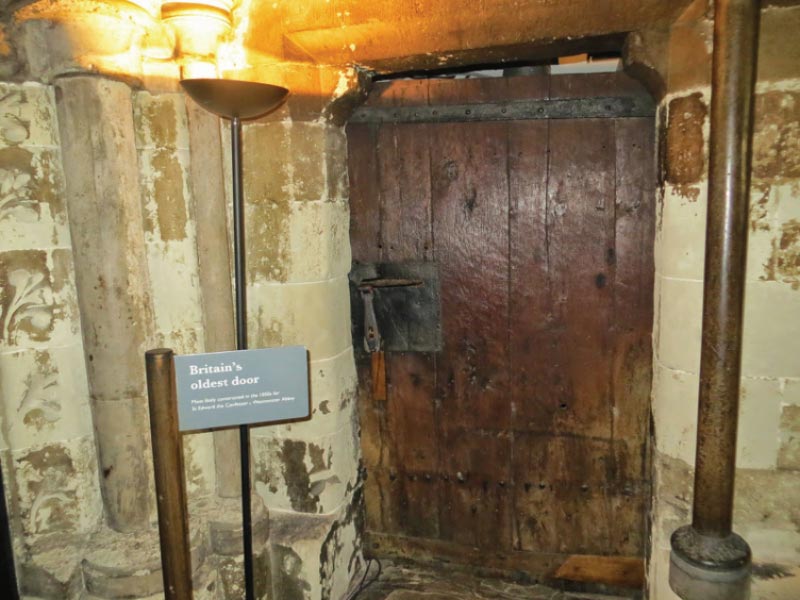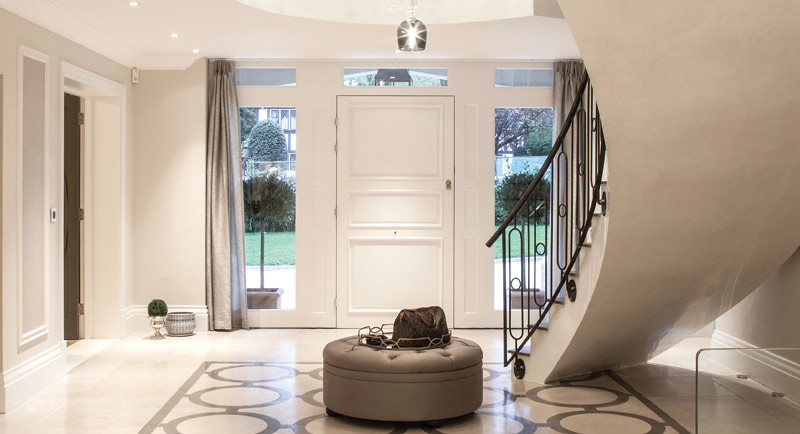Today the use of engineered defect free timber that is sustainably farmed and grown for enhanced durability with controlled moisture content has played a big role in improving the longevity of the UK’s entrance doors.
Pre-selection, removing knots and defects coupled with modern engineering methods of kiln drying and laminating timber sections together has taken great steps to aid in the prevention of dimensional twist and warp.
Gone are the days of hand painting doors and door frames to achieve the desired finish and colour scheme, factory applied coating systems are now extensively available offering a high quality and long lasting finish with low maintenance.
What does the colour mean?
A select number of psychologists believe that the chosen colour of your front door can be representative of your personality. Can you identify yourself with the attributes below?

- Red signals an assertive, active homeowner, one who is not afraid of attracting attention.
- Blue indicates you are easygoing and reliable.
- Black suggests a conservative homeowner, one who appreciates timeless values and tends to be private.
- Green shows that people are somewhat traditional, friendly neighbours who are active members of their communities.
- Purple signals a risk-taker who values the unique.
- White denotes an organized, logical individual.
- Yellow implies this homeowner likes to stand out in the crowd and is a natural leader.

Whether people can tell what your personality is from the colour of your front door remains to be seen, but at Bereco we know that the front door is a statement; the key center piece of a home country cottage or Georgian mansion.
History Of The Front Door
From Humble Beginnings
Believe it or not, front doors date back in history to the ancient Egyptian times when doors were considered a security blanket, no matter how big or strong the door was or wasn’t, it provided a physical barrier between the inhabitants and the world outside.
The most ancient of doors were made from timber, the oldest door in England can be found within the vestibule of the Chapter House in Westminster Abbey and dates from around 1050 A.D. The door is made from one Oak tree, with its rings suggesting it grew between AD 924 and 1030. It features vertical planks with horizontal bracing has five panels and is 6.5ft high by 4ft wide.

Whilst time honored patterns are still widely available and remain ever popular, construction methods have changed tremendously over the last century, no longer do timber doors bow and twist, get stuck or cannot be shut, they can now stand the test of time and in all environments from the Scottish highlands to the coastal towns of Great Britain, everyone can have a beautiful trouble free timber door.
Early designs were basic. Planked doors; where a ledged and braced design (named for their diagonal and horizontal bracings) were employed to prevent the timber planks from twisting. Eventually these gave way in the early 17th century to a more sophisticated plank style door that was made up of a stile and frame structure with infill panels of planked timbers, featuring Mortice and Tenon joints. This new design offered much more stability and remains reminiscent of today’s construction methods.
Frame and raised panel doors became popular during the Georgian era after the great fire of London at the end of the 17th century where in rebuilding the city this design became widespread amongst the aristocracy looking to create a statement in the new city. This design change not only improved the aesthetics making them more grand than ever before but the new design also went a long way to improve dimensional stability minimising expansion and contraction of the timber.
As technology and factory machining developed towards the end of the 19th century doors were the subject of embellishment; mouldings became more elaborate and varied in design than ever before but in essence the frame and panel door remains unchanged even today.
A Grand Entrance
In Britain the main entrance door was always elaborately designed and colored to demonstrate the homeowner’s wealth and status to passersby and visitors. It was not only the style but how the door was finished and dressed and the sheer size of the door that indicated wealth and status. The colour of the door, the glass pattern and ornate detailing of ironmongery showed great standing.

In the Georgian era, doors typically would have been a simple six paneled design without glass. The two smaller top panels may have been changed to glass in the later Georgian or Victorian periods but the use of the entrance door as the center piece of a home’s architecture remains popular to this day.
The Front Door’s of Today
Engineered Timber
Today the use of engineered defect free timber that is sustainably farmed and grown for enhanced durability with controlled moisture content has played a big role in improving the longevity of the UK’s entrance doors. Pre-selection, removing knots and defects coupled with modern engineering methods of kiln drying and laminating timber sections together has taken great steps to aid in the prevention of dimensional twist and warp.
Factory Applied Coatings
Gone are the days of hand painting doors and door frames to achieve the desired finish and colour scheme, factory applied coating systems are now extensively available offering a high quality and long lasting finish with low maintenance. Factory applied coating systems involve a staged process in their application firstly; the application of a preservative treatment that offers protection against rot and fungal decay. Secondly, basecoat or primer is applied. Thirdly, an intermediate coat where joints and end grain receive protection is given and finally top coat with UV protectors is applied leaving a blemish free long lasting finish.
British Standards

British standards have also gone some way to improving the overall quality of timber doors; for example BS644:2012 and BS6375 Parts 1, 2 and 3 all concern themselves with improving the performance of today’s door sets but manufacturers can also take this one step further and join third party accreditation schemes. These schemes, a sign of commitment by the manufacturer, not only check product quality and performance through testing but also audit factory controls and processes ensuring consistent quality for every product being manufactured.
Bereco Front Doors
In 2003 Bereco entered the timber windows and door market our aim to ‘Deliver the Difference’. We continue to operate by that same philosophy today with all our doors combining the very latest manufacturing methods; highest quality timber and ironmongery available.
Using engineered defect free timber, we manufacture 92mm frames and 68mm door leafs for all of our Entrance doors that offer rigidity and strength to all our door sets.
Robust frames, high security door cylinders and multi point espagnolette locking systems make our doors one of the most secure timber doors available in the UK. Fully tested and third party certified to PAS24:2016 our doors are available compliant with both Part Q of the Building regulations and as a licensed Secured by Design product.
Ultra Modern Door Designs
Traditional designs with painted, stained or dual colour factory finishes allow the creation of a statement entrance, and whilst we offer an extensive range of classic and heritage style doors and an unlimited number of bespoke designs, over recent years there has grown the need for more contemporary and modern designs.

The Bereco Creative Range is an exclusive collection of ultra-modern door designs crafted using sharp lines and flush panels to create a minimalist appearance perfect for contemporary properties or traditional properties looking to add a modern design twist.
